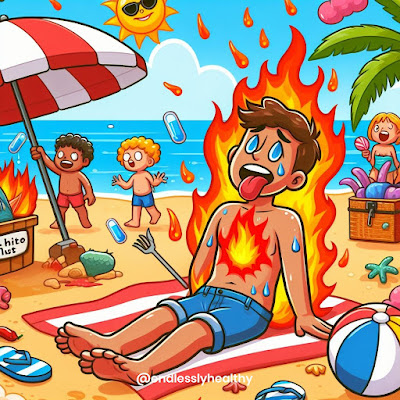Summer is here, and with it comes sunshine, vacations, and hopefully, plenty of outdoor adventures. But that sunshine can also bring some hidden dangers, especially when it cranks up the heat. One of the most serious threats is heatstroke, a condition where your body overheats and can't cool itself down.
This blog post is your guide to staying safe and healthy in the hot weather. We'll break down what heatstroke is, how to spot the warning signs, and most importantly, how to keep yourself and your loved ones cool and comfortable all summer long.
Understanding Heatstroke: When Fun in the Sun Gets Serious
Imagine your body is like a finely tuned machine. To function properly, it needs to maintain a certain temperature. When it gets too hot outside, your body kicks into overdrive to cool itself down. It sweats, increases blood flow to the skin, and tries to radiate heat away.
But sometimes, especially in hot and humid conditions, your body just can't keep up. This is when heatstroke can occur. Your core temperature skyrockets, and your body starts to malfunction. Organs can become damaged, and in severe cases, heatstroke can even be fatal.
Spotting the Signs: How to Tell if Someone is Having Heatstroke
Here's the thing: heatstroke doesn't always announce itself with a big, booming voice. The symptoms can vary depending on the person and the severity of the condition. However, some key warning signs to watch out for include:
- High body temperature: This is the most obvious sign, but it's important to note that someone experiencing heatstroke might not always be sweating.
- Confusion, dizziness, or headache: Your brain is super sensitive to heat, so if it's getting too hot, your thinking can become cloudy.
- Nausea or vomiting: Your body might be trying to get rid of anything that could be generating extra heat.
- Rapid breathing or heartbeat: Your body is working extra hard to try and cool itself down.
- Seizures or loss of consciousness: In very severe cases, heatstroke can lead to these more serious complications.
If you suspect someone is having heatstroke, call 911 or your local emergency services immediately. Don't wait for all the symptoms to show up before taking action. Heatstroke is a medical emergency, and getting help quickly is crucial.
Beating the Heat: How to Stay Cool and Prevent Heatstroke
Here's the good news: heatstroke is entirely preventable! By taking some simple precautions, you can stay safe and enjoy the summer sun to the fullest. Here are some tips to keep in mind:
- Hydrate, hydrate, hydrate! This one can't be stressed enough. Even if you don't feel thirsty, drink plenty of water throughout the day. Avoid sugary drinks and alcohol, as they can actually dehydrate you further. Consider adding a pinch of salt to your water, especially if you're sweating a lot.
- Dress for the weather: Ditch the dark-colored clothes and opt for loose-fitting, lightweight clothing made from breathable fabrics like cotton.
- Seek shade and air conditioning: The hottest part of the day is usually between 10 am and 4 pm. If you can, schedule outdoor activities for the cooler morning or evening hours. When you're not outside, find some air-conditioned space to cool down.
- Pace yourself: Don't overdo it, especially during the hottest part of the day. If you're exercising or working outdoors, take frequent breaks in the shade and stay hydrated.
- Never leave children or pets in a hot car: Even for a few minutes, the inside of a car can become dangerously hot, leading to heatstroke.
Taking Care of Others:
It's not just about protecting yourself. Be mindful of those who might be more vulnerable to heatstroke, like:
- Infants and young children: Their bodies aren't as efficient at regulating temperature.
- Older adults: Their bodies may not respond as well to changes in temperature.
- People with chronic health conditions: Certain medical conditions can increase the risk of heatstroke.
Making Summer Sizzle Safely
By following these tips, you can beat the heat and make the most of your summer. Remember, staying cool and hydrated is key to preventing heatstroke. So, grab your water bottle, wear that breezy hat, and head out there to enjoy the sunshine – safely!
Bonus Tips:
- Plan ahead: Check the weather forecast before heading outdoors and adjust your plans accordingly.
- Take a cool shower or bath
Supporting Your Body's Defenses: A Note on Supplements
While staying hydrated and following the heat safety tips above are the most important ways to prevent heatstroke, some people choose to take supplements to support their overall health and well-being. It's important to note that supplements are not a magic bullet and should never be used as a substitute for proper heat safety measures.
However, if you're interested in exploring supplementation, consider a daily multivitamin with a focus on immune system health products LiveGood Daily Essentials Pack is one option that includes:
- Bio-Active Complete Multi-Vitamin for Men or Women: This provides a range of essential vitamins and minerals that can help fill any nutritional gaps and support overall health.
- D3-K2: Vitamin D plays a role in immune function, and K2 helps with its absorption.
- Ultra Magnesium Complex: Magnesium is involved in many bodily processes, including muscle function and nerve transmission.
Remember, it's always best to consult with your doctor before starting any new supplements. They can advise you on the appropriate dosage and potential interactions with any medications you're taking.
Enjoy a Safe and Healthy Summer!
By following these simple tips and recommendations, you can make the most of your summer without letting the heat get the best of you. So, stay cool, stay hydrated, and have a fantastic summer!






0 Comments